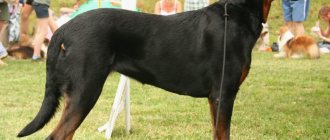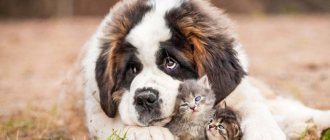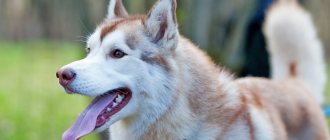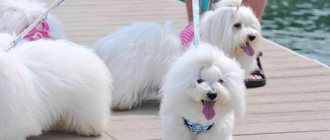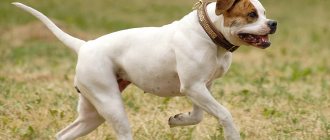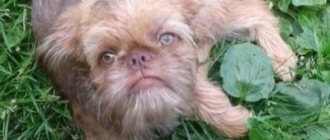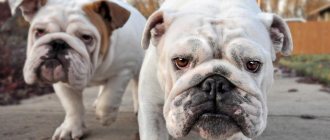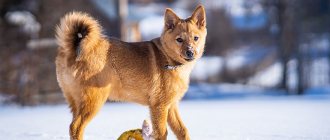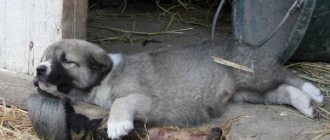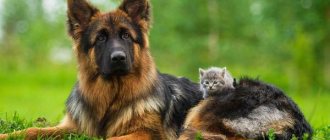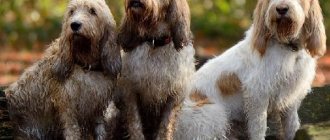| Origin | Switzerland |
| Usage | Herd protection, grazing, pack animal in the mountains |
| Color | A combination of three colors - black (main), red along the line of the paws and in the form of specks on the muzzle, white - from the forehead to the belly. |
| Dimensions | Large Swiss - from 50 to 68 kg; height – from 60 to 73 cm. Bernese – from 36 to 50 kg; height – from 58 to 70 cm. Entlebucher – 25 – 30 kg; height – from 42 to 50 cm. Appenzeller – from 22 to 32 kg; height – from 47 to 58 cm. |
| Lifespan | Large Swiss and Bernese Shepherds – 10 – 12 years. Entlebucher and Appenzeller live from 12 to 15 years. |
Sennenhunds have a long history. Dogs resembling them in appearance were discovered during excavations of a legionnaire camp of the Roman Empire. The agile dog helped protect flocks of sheep from predators. They retain their shepherd's inclinations even when living in apartments and take care of the safety of family members. The question of dog breed ownership remains unclear to this day: to which group they should be classified. It is believed that Sennenhunds may be relatives of Schnauzers, Molossians or Wolf-Molossians.
Other names for Sennenhunds are herding dogs and Swiss shepherds.
Breed standard
All Mountain Dogs have proportional shapes, sizes, and characteristic colors:
- Powerful Greater Swiss have a height of up to 72 cm; Bernese - from 58 to 70 cm, Appenzeller -50-58 cm; entlebuchers - 42-50 cm. Females are usually smaller than males.
- Color - tricolor. The standard fixes the location of brown inserts and the distribution of white color. The photo of all representatives of the Sennenhunds shows that they differ only in size and length of coat.
- Wool. All types of Mountain Dogs are short-haired, except Bernese.
- Large round head.
- Powerful neck with developed muscles.
- Broad chest and not long body with a wide chest.
- Drop triangular ears.
- The nose is black. The muzzle is white.
- The eyes are brown, almond-shaped.
- The tail is fluffy with a white tip in the Bernese Shepherd; in species with short hair, the tail is long or medium, dense. The Entlebucher's tail may be short, congenital, or long.
basic information
- Breed name:
Bernese Mountain Dog - Country:
Switzerland - Year:
1910 - Living in an apartment:
not recommended - Lifespan:
8 – 10 years
- Height of males:
61 – 61 cm - Bitches height:
58 – 69 cm - Male weight:
38 – 50 kg - Bitches weight:
36 – 48 kg - Owner experience:
suitable for beginners
The Bernese Mountain Dog is a large working dog, strong and agile, with strong legs and long hair, confident and fearless.
Character
All Mountain Dogs are loved due to their beauty and friendly, calm nature. It is these qualities that are prioritized by the standard. Peaceful animals leave the most pleasant impressions. Their performance characteristics make them useful and in demand.
All Mountain Dogs become very attached to the family into which they are adopted. Separation is difficult for them.
Greater Swiss Shepherd (gross)
A working dog that feels comfortable in outdoor conditions. May show self-will and stubbornness. Requires intellectual activities and contact with the owner.
Bernese Shepherd
A friendly, peace-loving and flexible dog. Treats all family members with care. Does not show aggression towards strangers. When danger threatens family members, the Swiss Mountain Dog instantly forgets that by standard he is friendly and peaceful, and fiercely protects his household.
Appenzeller
An active dog that requires regular training. Not aggressive. She is suspicious of strangers.
Entlebucher
The cheerful dog shows herding tendencies both on the farm and in an apartment, where the “herd” is a family, including cats and other pets.
Representatives of the breed with a documented pedigree behave in accordance with the description of the standard. Mestizos can fully inherit the characteristic characteristics of the breed, but often behave unpredictably.
Psychology
A dog with a stable psyche, calm and unobtrusive in the house. The pride of the representatives of the breed does not allow Bernese Mountain Dogs to ask for their master's affection and attention.
They do not accept physical punishment at all. You can control a dog only with the help of the established authority of the owner.
The attitude towards animals and children develops with a hint of condescension. These dogs, like German Boxers , get along easily with other pets.
Despite all of the above, a calm Bernese without the slightest delay is capable, like a fighting dog , of turning into a fearless and ferocious defender if the owner, his family or property is in danger.
Application
Sennenhunds are historically Swiss herding dogs. In some mountainous areas, large breeds continue to be used as herders. Small ones - used as companions. In mountain rescue teams, all Sennenhunds are used as rescuers to search for lost and injured people.
They can be security guards and perform watchdog functions. The breed is not aggressive. Sennenhunds attack extremely rarely. Calm, good-natured - they are ideal nannies for a child.
Socialization
The Mountain Dog, having a friendly character, treats all family members with equal love, although it becomes attached to one person. Herding instincts are inherent at the genetic level, so even a dog who is passionate about play always controls the safety of the “herd.”
Sennenhunds cannot stand being alone. A change of owners can negatively affect the psychological state of the animal.
Herding Shepherd Dogs show politeness to strangers, but do not allow familiarity from strangers. Pets are treated like family members. They don't compete for the top position. Domestic cats often take advantage of their gentleness and good nature, from which the Mountain Dog would prefer to retreat rather than engage in a fight. They love to play with children.
All Mountain Dogs have highly developed intelligence, are easy to train, and are good listeners. Grosses require additional mental stress.
Appenzeller Mountain Dog
Back in 1853, the first descriptions of this type of breed were found, which began to be bred first in Appenzeller, and then throughout Switzerland. Having become a separate breed, the Appenzeller Sennenhund won the hearts of amateur dog breeders and professional shepherds. And in our time, these animals continue to carry the main qualities of their ancestors, such as dedication, reliability, devotion, courage and endurance.
The Appenzeller Mountain Dog is not large in size and is light in weight. Like other Mountain Dogs, this species has a distinctive tri-colored coat and an athletic body. The energy of these dogs can be envied, as well as their physical strength. One of the distinguishing features is the amazing ability to be an attentive friend and a good helper. If you lead a fairly active lifestyle, then the Appenzeller Mountain Dog breed is ideal for you, reviews of which characterize dogs as excellent companions in outdoor activities and travel.
In many ways, dog lovers are attracted to the mischievous and cheerful nature of these animals. This is stated in numerous reviews. They are also capable of an affectionate and gentle attitude towards children, playing with them with pleasure. However, a certain condescension of the Appenzellers still does not allow them to lose vigilance, defending their honor and dignity. Many people like the fact that a family-friendly dog is extremely wary of strangers, because this makes the training process easier.
How to choose a puppy
The best place to buy a puppy is a nursery or from breeders with a good reputation and recommendations. Before purchasing, you need to check the documents confirming the pedigree and look at the conditions of detention. The optimal age for purchasing a puppy is 2 – 3 months. During this period they are already quite independent.
When choosing, you should take into account the developmental characteristics of individual breeds:
- Swiss Greater Mountain Dogs and Bernese babies develop more slowly than others. They begin to hear and see after three weeks. Until this age, they develop other ways of perceiving the world around them - smell, touch. For future socialization, the period of appearance and hearing is the most important. At this moment, the puppy’s fear can affect the formation of its character in the future, making it fearful and anxious.
- Appenzellers and Entlebuchers develop quickly. From an early age they show curiosity and activity.
You don't choose a puppy based on a photo. Directly at the nursery you need to pay attention to some important points:
- Externally, babies should look well-fed, strong, with powerful paws and an impressive constitution.
- Behavior – active, inquisitive, without the slightest signs of fear.
- They should not be frightened by loud noises or strangers.
- Correct bite.
- Eye color. Blue ones are unacceptable.
- The gait is wide and sweeping. Small mincing steps are unacceptable for representatives of this breed.
- The paws are strong, without bending. There should be no lameness.
Features of maintenance and care
All varieties of the breed do not require special care, especially the short-haired representatives.
It is enough to comb them during molting. Bernese Shepherds require more attention - they need to be brushed often, as they shed profusely and constantly. If the fur is dirty, you can bathe it.
It is necessary to keep the ears clean and regularly wipe the inner surface with a cotton pad soaked in hygienic oil. Trim nails and brush teeth periodically.
Appenzellers and Entlebuchers need active walks, and Grossies (large Swiss Shepherds) need regular exercise. You can go for short distance runs while monitoring your pet’s condition. The Bernese Mountain Dog should not be overtired.
The main thing when keeping shepherd dogs is friendly relations and attention. Mountain Dogs love to play. You can do this both at home and while walking outside.
All species of this breed need to be trained in order to ultimately obtain an intelligent companion who is predictable in his behavior and actions. Harsh training is unacceptable.
Aggression and a raised voice are not acceptable when raising Swiss Cattle Dogs.
Regular classes aimed at consolidating certain skills and memorizing commands will give the desired result with the owner’s benevolent persistence and patience.
Combing
Mountain Dogs' coat is naturally shiny and silky. Not all Mountain Dogs shed heavily. Therefore, short-haired dogs are brushed with a damp special mitten once a week, long-haired dogs are combed out more often - 2-3 times a week. If this is not done in a timely manner, the lost hair will get into shreds, forming tangles. They should be cut off as they cause pain to the dog by tightening the skin. In addition, an animal with mats looks unkempt.
Seasonal shedding occurs twice a year, and during this period the fur falls out especially intensively. The number of combings needs to be increased. In summer, if dogs suffer from the heat, they can be cut.
Bathing
You should bathe your Mountain Dog when its fur is very dirty. It is not advisable to carry out the procedure more than once a month.
Walk
The Bernese Mountain Dog, despite its impressive growth and developed muscular system, does not like much physical activity. They quickly use up the energy accumulated between walks. After a burst of vigorous activity, the Swiss Shepherd prefers a leisurely walk with the owner or will be happy with the opportunity to simply sit next to him and watch what is happening around him.
Grosses are large, hardy dogs, so they need exercise and long walks. Entlebuchers and Appenzellers love walks. Active games are necessary for their good mood and well-being.
Nutrition
The diet for both a large dog prone to obesity and a medium-sized dog needs to be carefully selected. Improper nutrition can cause deterioration in health, impaired development of puppies, hair loss, and skin diseases.
An important part of the diet is the vitamin complex. Vitamins are necessary for the proper formation of soft and bone tissues and the normal functioning of internal organs. Before giving vitamins, you should consult your veterinarian.
Puppies' diet should be high in protein. Babies are actively growing and they need this component for proper and complete formation and growth. Up to 6 months, feeding is done at least 5 times a day. By six months, the number of meals is gradually reduced to 3 times. Adult dogs are fed twice a day - morning and evening, at the same time.
Since Mountain Dogs are not dogs that lead an active, mobile lifestyle, the protein content in their daily diet should not exceed 28%. The minimum amount is 18%.
Proper nutrition for Mountain Dogs includes:
- Offal and meat. It should be given with a high content of veins and cartilage. Be sure to include tripe in your diet. Firstly, they love it, and secondly, it is good for the digestive system.
- Cereals in the form of porridges cooked in water.
- Fruits, vegetables, raw or boiled.
- Cottage cheese.
- Sea fish, because it is rich in microelements and phosphorus. It is included in the diet once a week.
- Raw chicken egg, 1 – 2 pcs. once a week.
The food bowl should be removed immediately after finishing feeding, even if there is some left over. Clean drinking water must be available at all times.
An alternative feeding option is dry food. It must be premium or super premium. Fat content is minimal. It must be taken into account that large representatives have a tendency to be overweight.
Nutrition, quantity and regimen must be taken responsibly. Feeding should be done at the time and in the volumes required by the breed, taking into account weight and age.
Sprinkling food between feedings, arguing that the dog is looking with hungry eyes, is not acceptable. It is strictly forbidden to give sweets, salty foods and smoked foods.
Health
Large Mountain Dog puppies develop quite slowly. Full maturity occurs at 2 years. Large dogs develop bones slowly, so puppies should be exercised moderately to prevent injury.
Hereditary diseases in puppies are difficult to identify. We have to rely on the integrity of the breeders conducting breeding.
Diseases
The herding dog is in good health. But large Sennenhunds are prone to joint diseases - elbow and hip dysplasia, and can also develop pancreatitis and bursitis.
Diseases transmitted by inheritance are detected at different ages:
- Joint dysplasia can appear at 5 months, but it is usually diagnosed in eight-month-old puppies.
- Cancer. It is difficult to treat. The earlier the disease is detected, the greater the chance of saving the dog.
- Panostitis. Bone disease. It can be diagnosed from 5 months. Manifests itself in the form of lameness.
- Hypothyroidism. Can be detected up to 2 years. Externally it manifests itself as brittle wool and increased temperature. With further development – weight gain.
- Allergy.
- Gastric volvulus. May occur during physical activity immediately after eating.
- Eye diseases: retinal atrophy, entropy, cataract.
Vaccinations
Mountain dog puppies need to have their vaccinations as scheduled. You should consult your veterinarian about the sequence and timing. Vaccination against rabies and plague is mandatory.
Mating
Swiss Cattle Dogs become adults at 2 years of age. Therefore, despite the fact that dogs have their first heat every year and then every six months, they cannot be bred until they are fully mature. After birth, the next mating takes place a year later. Bitches over 7 years old do not participate in breeding.
How much do mountain dog puppies cost?
In the nursery you can buy puppies of different categories with the following pedigree:
- Without participation in exhibitions and breeding - from 20,000 to 25,000 rubles.
- For an exhibition career and breeding - from 35,000 to 40,000 rubles.
- Rare species (entlebucher) - from 40,000 to 60,000 rubles.
Reviews
- Nastasya, 37 years old, St. Petersburg
My husband brought a gross as a gift, I was warned that they were eccentric and wayward, but I managed to avoid problems. I started training from the age of 2 months, the result was not long in coming, by the time I was a year old I had the perfect dog. We even passed the “obedience” test. I feed only “Go” food - this is an average value food, but the quality is not inferior to the pro plan.
“Melok” is now 4 years old, he perfectly accepted the child into his pack, protects him, but we don’t leave him alone together, there’s not a lot of fur, she sheds 2 times a year. We are glad.
Share link:
Nurseries
The Mountain Dog is one of the most popular dogs. In Russia, you can buy a puppy in a kennel or from breeders:
- in Moscow, the nursery “Village of Berntsev”bernendorf.ru;
- in St. Petersburg – spb-zennen.narod.ru/
The Swiss Mountain Dog is a wonderful friend, companion, and guard. Characteristics and temperament make him a full-fledged member of the family, caring and kind. In order for the dog to feel loved (this is very important for this breed), it is necessary to take care of him: devote time to walks, education, and games. When choosing a mountain dog as a pet, you need to be 100% sure that he will not have to change his home and family during his life.
Walk
Particular attention should be paid to physical activity. Unlike similar dog breeds, the Bernese does not need a large number of them.
You can just take a long walk with your pet, go for light jogs from time to time, and play with him.
Important! For the Bernese Mountain Dog, the main thing is the company of the owner and his attention. No matter how energetic your walks are, the most important thing is that you are nearby.
The game with a stick, shown in the photo, is one of the favorites of this breed.
